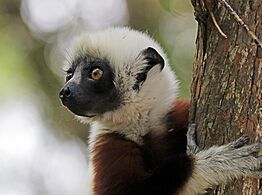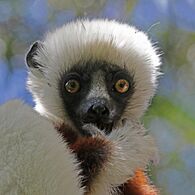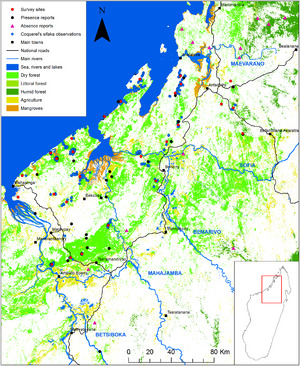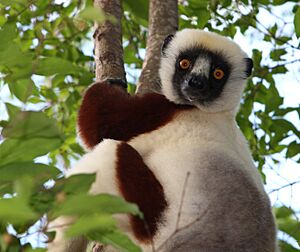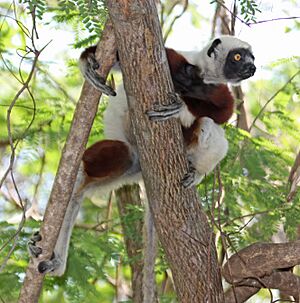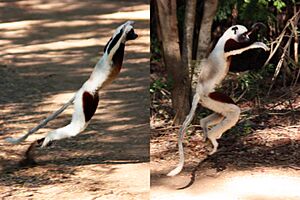Coquerel's sifaka facts for kids
Quick facts for kids Coquerel's sifaka |
|
|---|---|
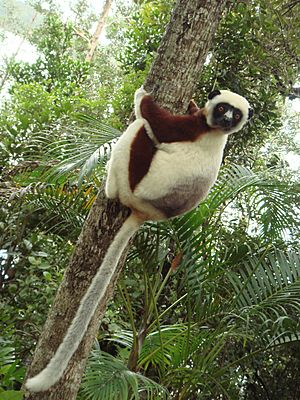 |
|
| Conservation status | |
| Scientific classification | |
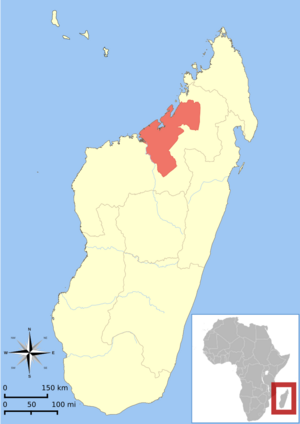 |
|
| Distribution of P. coquereli | |
| Synonyms | |
|
The Coquerel's sifaka (Propithecus coquereli) is a medium-sized lemur that is active during the day. It belongs to the sifaka family and lives in the wild only in northwest Madagascar.
This lemur was once thought to be a type of Verreaux's sifaka. But scientists later decided it was its own unique species. Today, it is listed as Critically Endangered by the IUCN Red List. This means it is at a very high risk of disappearing forever. Its main threats are losing its home and being hunted. Many people know the Coquerel's sifaka because it was the main character in the children's TV show Zoboomafoo. The species is named after a French insect expert, Charles Coquerel.
Contents
What They Look Like
Coquerel's sifakas have white fur on their backs and tails. They also have reddish-brown patches on their chests and parts of their arms and legs. Their fur is usually thick and soft.
Their faces are black and bare, except for a special white patch of fur on the bridge of their nose. Their ears are also black and bare, and their eyes are yellow or orange. The bottoms of their hands and feet are black. Their upper legs, arms, and chest are a chocolate brown color. Like all lemurs, Coquerel's sifakas have a special "toothcomb." This is a set of teeth used for grooming their fur and sometimes for scraping fruit off seeds.
Where They Live
Coquerel's sifakas live in the dry forests of northwestern Madagascar. They are found at low altitudes, usually less than 300 feet high. They live in coastal forests and areas between the Betsiboka River and the Maevarano River. Scientists have explored these areas and confirmed the sifakas are present in most forest parts between these rivers.
Groups of these lemurs have a "home range," which is the area they usually live in. This area is about 4 to 9 hectares in size. A study in Ankarafantsika National Park found that there might be around 47,000 sifakas living there. These lemurs are often seen near villages and in areas with non-native trees.
What They Eat
Coquerel's sifakas are herbivores, meaning they only eat plants. Their diet changes with the seasons. In the wet season, they eat young leaves, flowers, fruits, bark, and dead wood. In the dry season, they eat older leaves and buds.
They might eat nearly 100 different types of plants. But they spend most of their feeding time on only about 10% of these plants. Because they eat a lot of tough plant fibers, Coquerel's sifakas have a special digestive system. They have a large cecum and a very long colon. These help them digest their fibrous diet.
These lemurs spend 30-40% of their day looking for food. They especially forage in the morning, midday, and evening. Female sifakas often lead the group when foraging. They show their dominance by eating their favorite foods first or by not letting males eat until they are full. These lemurs help the environment by spreading seeds from the fruits they eat.
How They Behave
Coquerel's sifakas live in groups of about three to ten individuals. These groups are "matriarchal," meaning the females are in charge.
They are active during the day and mostly live in trees. Scientists have learned a lot about their behavior by watching them in the wild and in zoos.
Social Life
Coquerel's sifakas spend most of their time in small areas, about 2 to 3 hectares. However, their full home range can be larger, from 4 to 8 hectares. Even if their home ranges overlap with other sifaka groups, they try to avoid each other to prevent fights. When friendly Coquerel's sifakas meet, they greet each other by rubbing their noses together.
It is rare for animals to have a matriarchal system, but it is common among lemurs. In Coquerel's sifakas, the females are very clearly dominant over the males. All adult females, and even most younger females, are in charge of the males.
Females get to eat first and have better access to other important things. If a female is eating from a tree, a male will wait for her to finish before he goes to eat there. If a male gets in a female's way, she might lunge at him, smack him, or even bite him. The male will then show he is submissive. He might put his tail between his legs, make soft chattering sounds, and show his teeth in a grimace. Then he quickly jumps out of her way.
When they mate, female Coquerel's sifakas often mate with more than one male. This is called "polyandry." A female might choose to mate with just one male, but usually she mates with several. These males can be from her own group or from other groups visiting. Males will fight to mate with females. However, the male who wins a fight is not always the one the female chooses to mate with. The female's choice is more complicated.
Scientists think that when paternity is unclear (meaning males don't know if they are the father), males are less likely to harm baby sifakas.
Having Babies
Female Coquerel's sifakas choose their mates. They can choose males from their own group or from other groups. Females are ready to mate in January and February. Babies are born in June and July, after about 162 days of pregnancy. Usually, only one baby is born during Madagascar's dry season.
Newborn lemurs weigh about 100 grams. A baby sifaka clings to its mother's chest for about a month after birth. Then it moves to her back. Babies stop drinking milk and become fully independent around six months old. They reach their full adult size between one and five years old.
Males and females become old enough to have their own babies around two to three and a half years old. Some do not have their first baby until they are six. Coquerel's sifakas have been known to have babies with other species, like the Verreaux's sifaka.
How They Move
In the trees, Coquerel's sifakas move by clinging to tree trunks and branches and then leaping. They stay upright when they are resting or when they jump between branches or trunks. This way of moving in trees is common for most lemurs. This lemur can jump from tree to tree up to 35 feet away. They are amazing at leaping to thorny trees and placing their hands and feet exactly right so they don't get hurt.
Sometimes, Coquerel's sifakas come down to the ground to cross open areas. How they move on the ground is special to their species. Like Verreaux's sifaka, they move by hopping on two legs. They throw their arms out to the sides to keep their balance. However, while Verreaux's sifaka hops sideways and crosses its legs, the Coquerel's sifaka hops forward, like a kangaroo. It leans in the direction of its jump to get forward speed.
A study looked at how sifakas use their hands when eating. Adult male and female sifakas mostly preferred using their left hand to grab food. Younger sifakas used both hands. Coquerel's sifakas get better at using their hands and develop a hand preference as they get older.
How They Communicate
Coquerel's sifakas use many different ways to communicate. They use sounds, body language, and smells. The name "Sifaka" comes from the sound these lemurs make, which sounds like "shif-auk." The first part is a low growl, and the second part is a clicking sound like a loud hiccup. They use the "shih-fak" call to warn their group about a predator on the ground or to scare away enemies. Coquerel's sifakas are very protective of their territory.
When groups are traveling, they use soft grunts and growls to stay in touch. If a sifaka gets separated from its group, it might make a long, loud wail to find them.
One way Coquerel's sifakas communicate visually is by quickly jerking their head backward. This is a threatening action that might go along with the "shih-fak" call.
Sifakas also use scent a lot to communicate. Males usually mark their territory by rubbing a gland in their throats back and forth along branches. Females are more likely to mark with glands near their rear end. Scientists are still learning exactly what information these scents carry, besides marking territory.
A study on sifaka sounds found that loud barks are used when they see birds of prey. The sifakas look up and climb down. The "tchi-fak" sounds are used when they see predators on the ground. The sifakas look down and climb up. The meaning of growls seemed to change depending on the group. In areas with many birds of prey, growls meant a bird of prey was near. In other areas, growls meant a small disturbance.
Why They Are Important to People
Coquerel's sifakas, like many lemurs, are studied by scientists. This helps scientists learn about how primates, including humans, have changed over time. They have been studied to understand how color vision developed, how fathers care for their young, how female-led societies work in primates, and what causes new species to form.
Their Future and Threats
Even though Coquerel's sifakas are found in many places, they only live in two protected areas in Madagascar. These are the Ankarafantsika National Park and the Bora Special Reserve. They are a critically endangered species, which means they are in great danger of disappearing. They are also listed in CITES Appendix I, which means international trade of them is banned.
The biggest threats to their survival are deforestation (cutting down forests), habitat fragmentation (their homes being broken into smaller pieces), and hunting. Local people often clear trees to make new farmland, especially in wet areas where rice can grow. In northwestern Madagascar, forests are also burned each year to create new grazing land for farm animals. Trees are also cut down to make charcoal.
Many local traditions in Madagascar used to forbid hunting Coquerel's sifakas. One such tradition comes from a story: A young boy went into the forest to find honey. He saw a beehive high in a tree and climbed up. As he reached for the honey, bees attacked him. The surprise made the boy lose his grip, and he fell. He was surely going to die. But as he fell, a large lemur suddenly appeared. It swooped in and caught the boy, saving his life. Since that day, lemurs became sacred to the Malagasy people. It is said that anyone who kills a lemur will have very bad luck.
However, these protective traditions are becoming weaker as cultures change and more people move into the area.
This lemur is now hunted for food. But humans are not the only danger. New animals brought to Madagascar, like cats and dogs, have also harmed the Coquerel's sifaka. Groups like Projects for Animal Welfare encourage people to spay and neuter cats and dogs on the island. This helps protect the native wildlife. Even the protected areas where Coquerel's sifakas live offer them little safety. They are hunted even inside Ankarafantsika National Park, and the Bora Special Reserve has been badly damaged.
Who Hunts Them
Many animals hunt Coquerel's sifakas. Hawks and other birds of prey attack them from above. Snakes and the fossa threaten them from the ground. Introduced predators like wild dogs, African cats, European cats, mongooses, and civets also hunt them. However, of all these creatures, humans are the biggest danger. Even though killing lemurs was once forbidden, Coquerel's sifakas now see humans as a threat. They may make an alarm call to warn others.
Some lemurs do not realize how dangerous humans are and will approach people on the ground. To scare away predators they do recognize, the lemurs make a warning call. They also stare at the threat and shake their heads back and forth.




